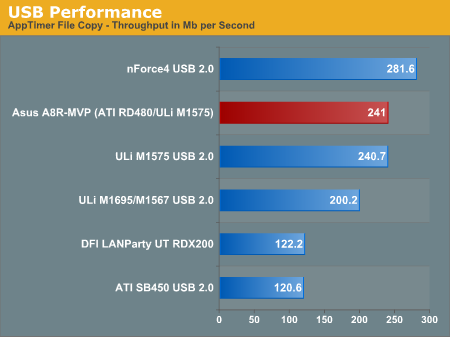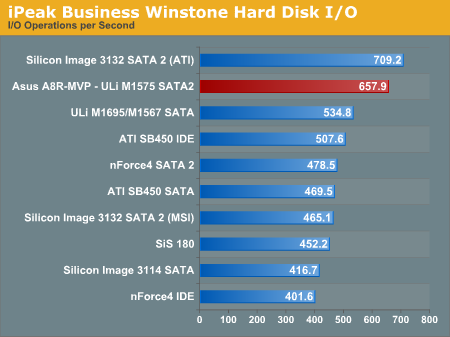Asus A8R-MVP: Mainstream Rocket
by Wesley Fink on November 23, 2005 1:15 AM EST- Posted in
- Motherboards
USB Performance
USB has been a problem area for the ATI SB450 chipset, so we were anxious to test the ULi M1575 South Bridge, which is supposed to fix USB performance issues. We ran our standard USB throughput test on the Asus A8R-MVP using an external USB hard drive.
Our test method uses a RAM disk as our “server”, since memory removes almost all overhead from the serving end. We also disable disk caching on the USB and Firewire side by setting up the drives for “quick disconnect”. Our results are then consistent over many test runs.
We use just 1GB of fast 2-2-2 system memory, set up as a 450MB RAM disk and 550MB of system memory. Our stock file is the SPECviewPerf 8.01 install file. which is 432,533,504 bytes (412.4961MB). After copying this file to our RAM disk, we measure the time for writing from the RAM disk to our external USB 2.0 or Firewire 400 or Firewire 800 drive using a Windows timing program written for AnandTech by our own Jason Clark. The copy times in seconds are then converted into Megabits per second (Mb) to provide a convenient means of comparing throughput. Higher Rates therefore mean better performance.
In addition to competitive USB performance, the M1575 also provides the SATA2 ports that are missing from the ATI SB450. The ULi SATA2 also supports RAID 0, 1, 0+1, 5, and JBOD.
Disk Controller Performance
With the variety of disk drive benchmarks available, we needed a means of comparing the true performance of the wide selection of controllers. The logical choice was Anand's storage benchmark first described in “Q2 2004 Desktop Hard Drive Comparison: WD Raptor vs. the World”. To refresh your memory, the iPeak test was designed to measure "pure" hard disk performance, and in this case, we kept the hard drive as consistent as possible while varying the hard drive controller. The idea is to measure the performance of a hard drive controller with a consistent hard drive.
We played back Anand's raw files that recorded I/O operations when running a real world benchmark - the entire Winstone 2004 suite. Intel's iPEAK utility was then used to play back the trace file of all IO operations that took place during a single run of Business Winstone 2004 and MCC Winstone 2004. The drive was formatted before each test run and a composite average of 5 tests on each controller interface was tabulated in order to ensure consistency in the benchmark.
iPeak gives a mean service time in milliseconds; in other words, the average time that each drive took to fulfill each IO operation. In order to make the data more understandable, we report the scores as an average number of IO operations per second so that higher scores translate into better performance. This number is meaningless as far as hard disk performance is concerned as it is just the number of IO operations completed in a second. However, the scores are useful for comparing "pure" performance of the storage controllers in this case.
USB has been a problem area for the ATI SB450 chipset, so we were anxious to test the ULi M1575 South Bridge, which is supposed to fix USB performance issues. We ran our standard USB throughput test on the Asus A8R-MVP using an external USB hard drive.
Our test method uses a RAM disk as our “server”, since memory removes almost all overhead from the serving end. We also disable disk caching on the USB and Firewire side by setting up the drives for “quick disconnect”. Our results are then consistent over many test runs.
We use just 1GB of fast 2-2-2 system memory, set up as a 450MB RAM disk and 550MB of system memory. Our stock file is the SPECviewPerf 8.01 install file. which is 432,533,504 bytes (412.4961MB). After copying this file to our RAM disk, we measure the time for writing from the RAM disk to our external USB 2.0 or Firewire 400 or Firewire 800 drive using a Windows timing program written for AnandTech by our own Jason Clark. The copy times in seconds are then converted into Megabits per second (Mb) to provide a convenient means of comparing throughput. Higher Rates therefore mean better performance.

In addition to competitive USB performance, the M1575 also provides the SATA2 ports that are missing from the ATI SB450. The ULi SATA2 also supports RAID 0, 1, 0+1, 5, and JBOD.
Disk Controller Performance
With the variety of disk drive benchmarks available, we needed a means of comparing the true performance of the wide selection of controllers. The logical choice was Anand's storage benchmark first described in “Q2 2004 Desktop Hard Drive Comparison: WD Raptor vs. the World”. To refresh your memory, the iPeak test was designed to measure "pure" hard disk performance, and in this case, we kept the hard drive as consistent as possible while varying the hard drive controller. The idea is to measure the performance of a hard drive controller with a consistent hard drive.
We played back Anand's raw files that recorded I/O operations when running a real world benchmark - the entire Winstone 2004 suite. Intel's iPEAK utility was then used to play back the trace file of all IO operations that took place during a single run of Business Winstone 2004 and MCC Winstone 2004. The drive was formatted before each test run and a composite average of 5 tests on each controller interface was tabulated in order to ensure consistency in the benchmark.
iPeak gives a mean service time in milliseconds; in other words, the average time that each drive took to fulfill each IO operation. In order to make the data more understandable, we report the scores as an average number of IO operations per second so that higher scores translate into better performance. This number is meaningless as far as hard disk performance is concerned as it is just the number of IO operations completed in a second. However, the scores are useful for comparing "pure" performance of the storage controllers in this case.












74 Comments
View All Comments
poohbear - Thursday, November 24, 2005 - link
thanks for clarifying.:) guess it's best to wait and see other reveiws to get a general consensus though.Calin - Wednesday, November 23, 2005 - link
Maybe the design team had a set of design cues for the board, received from the top (management) - these include cost, performance, reliability, and possibly even other metrics. The ATI chipset might have been too good for those cues, or maybe they worked to optimize the board - and told nothing to management about their substantial successes.Or maybe the board was a lucky one, and maybe 1 in 100 will get near those results, and the rest will be mainstream. Anyway, I think it is a good design, and not a lucky board
Calin
poohbear - Wednesday, November 23, 2005 - link
jesus 2900mhz on air?!!?? i LOVE competition.:)CrystalBay - Wednesday, November 23, 2005 - link
Hi Wes, Did you run into any coldboot problems ?Wesley Fink - Wednesday, November 23, 2005 - link
No Coldboot problems at working overclocks. We did find, however, that failed overclocks at very high frequencies usually required the system be turned off (power switched off) for the board to recover from the failed OC. This is common to many motherboards, but it is always easier if the board recovers on a warm boot.Diasper - Wednesday, November 23, 2005 - link
Just wondering why there weren't any game benchmark comparisons against the Asus A8N32 given the article set out by comparing them and given the numerous benchmarks with it including Aquamark, how come it was excluded from the rest of the game benchmarks?? It would be pretty nice/important if you included them.nvidia4ever - Wednesday, November 23, 2005 - link
I was wondering the same. Either the results are not favorable for ATI or there are results coming that were not posted yet. Either way it looks like a great board.Wesley Fink - Wednesday, November 23, 2005 - link
The original benchmarks with the A8N32-SLI Deluxe were run at 1600x1200 with AA/AF on. This is because we were trying to determine if Dual x16 SLI made any difference compared to Dual x8 SLI. When we tested the ATI we reran benchmarks on one of the current top nForce4 boards - the DFI LANParty nForce4 SLI - to provide a comparison with the nForce4 SLI chipset. We did not have the Asus A8N32-SLI available for retesting since another reviewer was using the board for benchmarking. It also didn't seem important to also rerun benches on the A8N32-SLI since its performance was comparable to the DFI nF4 SLI.At any rate, the A8N32-SLI is available again and we will rerun some benches at 1280x1024 and add results to the game graphs. For "Standard Score" benchmarks like 3DMarks and Aquamark 3 the video resolutions are always the same and the A8N32-SLI results are already included in the graphs.
Beenthere - Wednesday, November 23, 2005 - link
It was pretty obvious a year ago that ATI had created a very impressive chipset for the AMD Mobos. The Southbridge ULi chip resolves perceived deficiencies by those who believe they need faster USB and S-ATA 2, even though in reality this simply isn't true. The fact that the ATI Northbridge chipset O/C's so well is proof of an excellent design and one to build a Helleva reputation on in the Mobo market. The ATI chipset makes it pretty obvious that you don't need to endure high prices and marketing gimmicks of some Mobo mfgs. to promote over-priced "gamers or overclockers" Mobos that don't deliver as much, let alone more PC performance than the ATI chipset Mobos, which include all the practical overclocking BIOS options anyone would possibly need.sunshine - Wednesday, November 23, 2005 - link
RE: "Our first efforts at overclocking the A8R-MVP ran into a road block at just over 260. We have found some Asus boards in the past that did not like overclocks to be immediately set to high values, so we started again at 250. By going up just 5 to 10FSB at a time, we were able to reach 325."What is it exactly that prevents you from setting up the overclocking settings all at once? Why must you increase at only 5 - 10 mhz at a time? Is the Asus Bios boobytrapped to prevent someone from frying their motherboard or CPU???